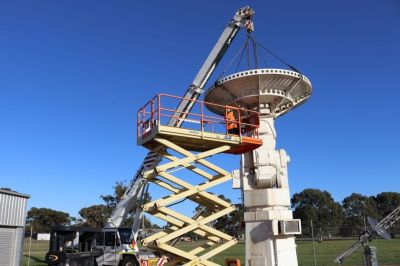In a bit of rare Australian space news, the Arnhemland Historical Society has managed to save one of the satellite trackers used during the 1960s and 1970s from the scrap heap. As the Space Race intensified during the 1950s and 1960s, every nation wanted a piece of this new technology. A number of European nations banded together in the form of ELDO, the European Launcher Development Organisation.
Australia was a partner in this program, with launches of the Europa-1 and Europa-2 rockets taking place from Woomera, South Australia. Initially the UK’s cancelled Blue Streak IRBM program provided the first stage for Europa-1, but this was later replaced with the French Diamant. France also provided the Coralie second stage in addition to the German-developed Astris third stage.
The first launch of the Europa-1 took place in 1966, with the rocket performing well, but inaccurate readings from a radar station leading to the rocket to be wrongly instructed to self-destruct. Of nine launches, four were successful, with the satellite trackers at Arnhemland providing tracking support. Ultimately, the many technical setbacks led to the demise of ELDO, and it was merged by the 1970s into what is now the European Space Agency, with its main launch site in Kourou, French Guiana.
Despite the lack of success, these early days at Woomera were instrumental in getting Europe’s feet wet in the development of the Ariane rockets. Woomera’s rocketing days may also not be over yet, with NASA having announced in 2019 plans to use Woomera for launches.
Maybe one day Arnhemland will have its own space port, with the old satellite track on display to remind of those early days.
[Top photo: The ELDO satellite trackers were state-of-the-art when they stood in Gove in the 1960s. (Supplied: Arnhemland Historical Society)]
(Thanks, David)
















Those satellite trackers may no longer be state of the art but they sure as anything look cool.
I wouldn’t mind one in my rooftop, it doesnt look that big, around 3~5m diameter?
Some BUDs from the eighties were bigger, the real trick here is that these are military grade construction and fully steerable.
Is dish envy a thing?
Never mind the dish, I’d settle for that scissor lift!
Get one and modify it for EME! Dish envy is a real thing in the EME scene.
I love how they have panel lines that make them look like something from the Tatooine film set. What’s up with that?
Makes you thirsty for a cup of blue milk.
Yeah, functionality aside, these things look like some kind of industrial-elegant art installation to me.
“What’s up with that?”
Maybe after the massive layoffs due to the closing of the Apollo space program, at least one engineer found work designing movie sets?
B^)
For an article that’s titled to feature the satellite trackers, the article itself has pretty much nothing to do with them beyond a brief captioned picture noting their removal. The whole article is about rockets and the agency instead with no details on the trackers!
Exactly my disappointment..
It is ok …
Just a “feel good”, no-substance news, during COVID times ;-p
Just my plug* for the Hams using an old 60′ (~20 meter) dish in Colorado.
http://dses.science/
*I am not affiliated with these Hams, just jealous!
So, the dish (one of three?) in Australia was saved from the scrap heap, but is now a museum piece?
Well, that’s better than nothing!
For some more context – https://www.dst.defence.gov.au/publication/fire-across-the-desert
Could they be refurbished with an electrical and electronics refit and used as an up/down link to the Starlink system?
That would be nice, it might only take a PC and an SDR to complete the receiver side.
And now there are a lot more motor controller boards available to help steer the dish.
Depending on the designed frequency, could it be pointed at a geostationary sat and down load weather info
(to display at the museum)?
Looking at the last picture: love the box air conditioner facing North … guaranteed sunlight and heat … in hot and humid Arnhemland.
Obviously clueless UK engineers designed that!
Oops … re-reading …. they were in Woomera, not Northern Territory.
Apologies.
Remove the humid part but add MORE heat!
Ever been out to the Woomera Rocket Park? I’d like to visit should I ever get to Australia.
Miles and miles of bugger all….
As an Aussie I’m mildly offended by your opening line; “In a bit of rare Australian space news” as just 3 days ago this was the space news ” Australia’s first private space rocket blasts off from Koonibba Aboriginal community”
I’m not sure what your taking offense at…. Australian space news is fairly rare…. We haven’t put anything into orbit yet… From memory, the last really newsworthy event was when a piece of Skylab fell on us….
“Thus, in the incredibly short span of only 11 months, Australia’s first satellite, WRESAT (WRE Satellite) was designed, constructed, tested and finally launched on 29 November 1967…. when Australia became the fifth country (third from its own territory) to launch a satellite. ”
Prior to this, the Weapons Research Establishment (WRE, now DSTO) at Woomera, SA, was already supporting the launch of rockets that flew above the edge of space, nominally agreed as starting at 100kms altitude. The British Skylark missile carried research payloads up to 150kms, and was first launched on
13 February 1957.
Note that Sputnik 1 was launched on the 4th of October, 1957.